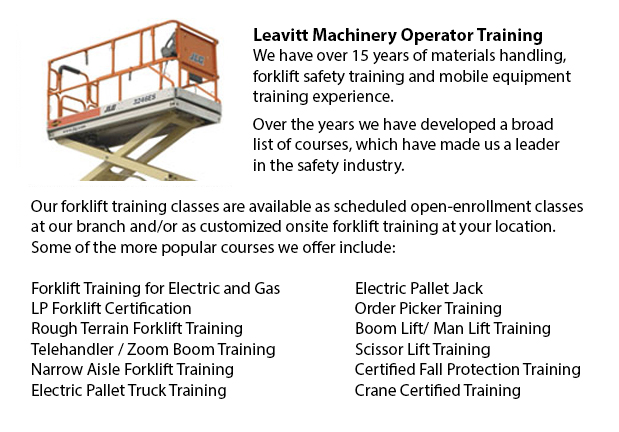
Scissor Lift Certification Burlington - Lots of worksites and tradespeople like for example iron workers, welders and masons utilize scissor lift platforms to be able to help them reach elevated work areas. The use of a scissor lift is often secondary to their trade. Hence, it is essential that all operators of these platforms be well trained and certified. Regulators, industry and lift manufacturers work together to make certain that operators are trained in safely utilizing work platforms.
Scissor lift work platforms are otherwise known as manlifts or AWPs. These work machinery are rather easy to use and offer a steady work setting, however they do have risks since they raise people to heights. The following are some important safety issues common to AWPs:
In order to protect individuals working around work platforms from accidental power discharge due to close working proximities to power lines and wires, there is a minimum safe approach distance (also referred to as MSAD). Voltage could arc across the air and cause injury to workers on a work platform if MSAD is not observed.
Caution must be taken when lowering a work platform to guarantee stability. The boom must be retracted, when you move the load toward the turntable. This would help maintain steadiness in lowering of the platform.
The regulations about tie offs do not mandate people working on a scissor lift to tie themselves off. Some organizations will on the other hand, require their personnel to tie off in their employer guidelines, job-specific risk assessments or local regulations. The manufacturer-provided anchorage is the only safe anchorage wherein lanyard and harness combinations must be connected.
It is vital to observe and not go over the maximum slope rating. The grade could be measured by laying a board on the slope or by laying a straight edge. Then, a carpenter's level can be placed on the straight edge and raised until the end is level. By measuring the distance to the ground and dividing the rise by the straight edge's length, then multiplying by 100, the per cent slope could be determined.
A typical walk-around check should be done to determine if the unit is mechanically safe. A location assessment determines if the work area is safe. This is important particularly on changing construction sites because of the chance of obstacles, contact with power lines and unimproved surfaces. A function test should be carried out. If the unit is used safely and correctly and proper shutdown measures are followed, the possibilities of incident are really lessened.
-
Order Picker Training Burlington
Order Picker Training Burlington - Order picker's enables warehouse employees to lift pallets using forks. Also called a stock picker, this particular electrically-powered equipment is similar to a forklift except that an order picker is likewise uti... More -
Crane Certification Burlington
Crane Certification Burlington - The Crane Certification training program includes content recommended by industry regarding the efficient and safe operation of cranes. Trainees would learn the following: how to identify cranes and their component pa... More -
Overhead Crane Training Burlington
Overhead Crane Training Burlington - The overhead crane is a piece of equipment which can lift and move huge, heavy objects which can't be handled by hands. Typically, overhead cranes are fixed in place. These equipment are capable of moving huge vol... More -
Aerial Lift / Boom Lift / Man Lift / Scissor Lift Training in Burlington
Lift tables or scissor lifts could elevate both people and goods vertically. They are normally used in construction, commercial and industrial environments. Commonly, the use of a scissor lift is to lift and lower supplies from one floor of a job loc... More -
Telehandler Operator Training Burlington
Telehandler Operator Training Burlington - Telescopic Handler forklifts or telehandler forklifts are usually found on construction places and their popularity continues to rise. The versatility of telehandler forklifts ensures that they are a valuabl... More -
Forklift Training Classes Burlington
Forklift Training Classes Burlington - Forklift are heavy pieces of industrial machines that are made use of in transporting and the handling of merchandise and materials. They are often known as Lift trucks and are found in all sorts of businesses.... More -
Boom Lift Training Burlington
Boom Lift Training Burlington - Aerial platforms or also known as elevated work platforms are devices that allow workers to perform tasks and duties at elevated heights that would not be otherwise accessible. There are a variety of aerial lifts avail... More -
Bucket Truck Training Burlington
Bucket Truck Training Burlington - The Vehicle-Mounted Aerial Work Platform or also called bucket truck training program is intended to decrease the risk of incident and personal injury while working in close proximity or with bucket trucks by effici... More

Forklift Training Burlington
TOLL FREE: 1-888-254-6157
Burlington, Ontario
forklifttrainingburlington.com
Email Us
About Us


